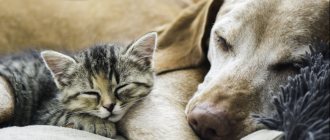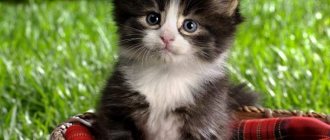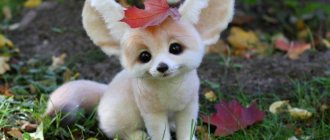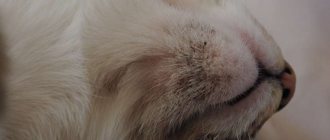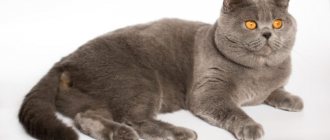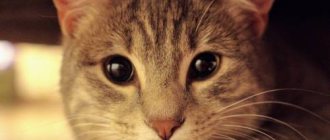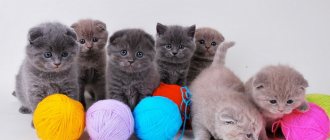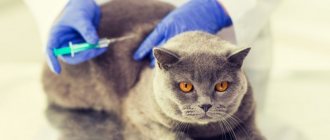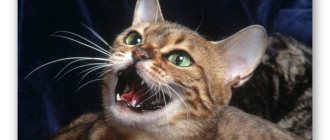Created 04/28/2014 16:03 Author: Evgeniy
If you love cats, then you probably know that every part of your little friend is simply adorable - from his fluffy paws to his tiny pink nose. But while you are touched by the sight of pointy ears and funny whiskers, you should remember that all these parts of the cat’s body serve certain purposes, which at first glance may go unnoticed. Let's take a closer look at cute cat paws, noses and tongues with the help of macro photographs and learn more about our furry (and for some, hairless) friends.
How to explain why cats are so cute according to most people?
Animals occupy a significant part of human life. Each of them has its own characteristics, but not everyone thinks about why cats are so cute and more preferable. A cat is a graceful and interesting creature. She constantly explores the world through her sense of smell. Kitty is interested in new objects in the house, and especially boxes and bags. Animals are considered treacherous and vindictive, but despite this, everyone is crazy about them.
Renaissance of erratives
Distortion of words and playing with letters and sounds are not alien to Russian culture and were popular among Russian futurists back in the 20s of the last century. And the popularity of words with deliberate errors in 2021 is an echo of the ten-year-old fashion for “bastard jargon” (also known as Padonkaff or Albanian language). “Afftar zhot”, “preved bear”, “ya krevedko” and other phrases became the product of Internet forums, which in the early 2000s were the main breeding ground for memes.
Correspondence on the Internet mixed the features of oral and written speech, and the informality of online communication is most easily expressed by abbreviations and words with deliberate distortion of spelling.
In the 2000s, erratives were used to emphasize carelessness and even some vulgarity of communication. “Kui” and other expressions masked obscene insults, all those who disagreed were sent “ftopka,” and funny viral videos were accompanied by numerous “laughs.”
By the end of the 2010s, the Internet became a full-fledged part of mass culture, and special words ceased to be a marker of a certain social group. The fashion for erratives has gone away for a while.
But in 2021 they are back - and much different. An echo of the times of “bastards” can be considered the meme that plays on the swear word “Blat Nevelny”, but mostly erratives have settled in harmless areas - among cute images of cats.
Why do cats and cats seem cute?
Subconscious and instincts of the human mind
Caring for furry animals is embedded in the human brain. According to Darwin's theory, humans evolved from apes. These animals always take care of the fur of their relatives. This is how they show care and love. According to research results, these habits still remain in the subconscious of a person. That’s why most people react with affection to animals with fluffy fur, and young animals seem the most attractive.
If dogs are capable of training and more clearly reflect the character of the owner, then cats are the complete opposite of this. They are arrogant and spoiled. These pets behave relaxed, and a person is always within both moral and ethical boundaries. But despite their temper and unpredictability, cats are much more often wanted in the house. Playing and relaxed kittens, who have become the object of observation, contribute to the release of part of this most suppressed energy. The observer experiences a feeling of relaxation, which is often interpreted as cuteness.
Character and quirks of cats
Each creature has its own personality traits. The owner is unable to completely correct them; he can only make some adjustments. These mammals are moral and cannot be changed. The character of cats is not formed from childhood. Some things are inherent in their habits by nature itself. And then throughout life, many factors make adjustments.
- Breed. Each species has its own characteristics - Persians love loneliness, and Siamese cannot stand it).
- Experience. Animals learn and explore the world throughout their lives. For example, after interacting with children who behaved cruelly, cats subsequently avoid them.
- Upbringing. Like children, cats are taught certain skills - eating from a bowl, going to the litter box, going for walks and returning home.
If you don’t want to find an unpleasant surprise in your shoes or bed, you shouldn’t kick or hit your four-legged pets. They will remember this for a long time and the revenge will be sweet.
Just feeding your pet and cleaning the toilet is not enough. Some people think cats are stupid, which is not true. An animal will not go to sleep next to someone it does not trust. Many owners confirm that a cat's purring is calming. The animal has highly developed instincts, thanks to which they are able to hear the sound of a canned food opening from the other end of the house or smell an enemy on their territory. The cat defends its possessions by pricking its ears, arching its back, ruffling its fur and hissing. In addition, cats are smart, beautiful, funny and mysterious.
Source
The Human-Animal Bond: Praise God
Medical researchers increasingly understand the value and importance of animals in helping people with disabilities and severe emotional or mental trauma. More and more, therapists are prescribing service dogs for people who are struggling with depression. I have seen many examples of the power of these bonds to comfort, help and heal. In fact, both sides win. For example, I have seen a dog help a soldier avoid a panic attack by cuddling and licking him. In return, the soldier takes care of the dog physically and emotionally; dogs are designed by the Creator to be social animals and benefit from healthy relationships. This is just one of many examples where trained animals improve the emotional and physical health of both people and animals. I was told about a horse, Comet, who was abused and experienced emotional healing through the gentle treatment of people who believed in Jesus Christ. She now takes part in equine therapy for girls who have suffered from abuse and drug addiction.
One girl was especially touched by this horse. The first day they met, the horse did not approach any person, but headed straight towards her. There seemed to be an immediate understanding and an emotional connection between them. This horse is like a bridge that will ultimately help the girl learn to trust people again. At the same time, the previously abused horse learned to trust and help people who had been hurt.
The ultimate goal for a girl is a renewed and transformed mind as the Spirit of God uses all of these mechanisms to bring her into a healthy relationship with Him. If the horse were not created with varying degrees of attractiveness and resemblance to us, how could humans care for, protect and bring healing to this animal? On the other hand, if these traits were not present in a horse, would it be possible to use it as a therapeutic bridge for the emotional and spiritual healing of another person?
They can easily be busy for several hours
Besides the balls of fur (which they can get tangled up and not get out), the iPad can also easily keep them occupied for hours. Believe it or not, there are videos on YouTube of cats turning around with their paws on iPad screens and being very surprised by the colors. If you don't want to sacrifice an iPad for your feline, a simple moth in the room should be enough! However, don't take it for granted that a cat will simply be surprised by anything and everything. The games will begin only when and only when Her Feline Highness wants to have some fun. We still wonder why they are adorable?
Language
When a cat licks your skin, the sandpaper sensation is caused by the papillae on its tongue. They look like tiny needles made of keratin, and their main function is to help the animal eat and tidy its fur. Thanks to these needles, cats can pick up small pieces of food and lick meat from bones.
While drinking, cats use their tongues to establish a delicate balance between gravity and inertia. The tongue only lightly touches the surface of the liquid and, thanks to special movements, creates an upward flow of water. The animal manages to close its mouth before gravity causes the water to fall back into the bowl. Cats lap at a rate of four times per second, which is too fast for the human eye to detect.
They use different "meow" tones to manipulate you
Whether you want cats to hum, entertain them, give them food, or show them TV, they have a special way of meowing for each activity. A slow, quiet meow signals that they want you to pet them under their necks. A short purr lets you know they are impressed. A loud, continuous meow is their way of telling you to “get out of here!” It's hard to think of anything cuter than this. In fact, there must be a research laboratory somewhere that is trying to decipher the various meows and make it the main language.
Alien-like beauty. Why Orientals are a welcome gift for true cat lovers
The Oriental breed, due to its unusual “alien” appearance, is considered one of the most exotic. At the same time, oriental cats can boast a variety of colors that none of their relatives have.
Oriental cats, also called “orientals,” are one of the most beautiful and unusual breeds, which became famous not only for their unusual appearance, but also for their variety of colors. Focus collected interesting facts about this beauty and figured out why an Oriental kitten can be an excellent New Year gift for those who are crazy about cats.
Read the best materials in the section on the “Focus” page. Lifestyle" on Facebook
Subscribe
An Oriental cat is essentially a Siamese cat that has a different color and green rather than blue eyes. These animals first appeared in Thailand (Siam), where they are mentioned in chronicles as fully colored cats, similar to the Siamese, but without the markings of this breed on the paws, tail and head. Orientals were considered sacred and lived in Buddhist temples. Their export from the country was allowed only at the end of the 19th century. Then they first came to England.
Over the next 100 years, not a single felinological council recognized Orientals as a separate breed, stubbornly classifying them as Siamese cats. The British gave the green light to their American colleagues to breed them as a separate breed in 1956, and two years later a breed standard was created and adopted in the USA. In 1966, the Havana (chocolate) color was declared the winner and is now considered the most typical of the Orientals.
Today there are about 300 colors of this breed, but felinologists still distinguish several basic colors: Havana, black (ebony), lavender (gray-pink color with hints of frost, but without a blue tint), blue, red, cream, fawn (beige), cinnamon (cinnamon color), white.
Types of colors also differ in the presence of spots: tortoiseshell (spots scattered throughout the body), tabby (color with a pattern), merle, brindle, spotted, ticked (coat hairs are colored in different colors along the entire length).
This animal has a flexible, long, slender and muscular body. The head of the Oriental is medium-sized, wedge-shaped with a straight, slightly flat nose. A distinctive feature of the breed is its large ears. Unlike the Siamese cat, the Oriental has green, not blue, eyes. The appearance of these cats is often called “alien”.
Orientals are a playful and very active breed.
Orientals make excellent companions. Like dogs, they become attached to “their” person, literally follow on his heels and will never betray him. If the owner is often away from home, it is better to have two animals from the same litter so that they do not get bored.
So that the Oriental does not feel sad in the absence of the owner, you can take him a companion from the same litter as him
It is worth remembering one feature of Orientals: if the animal got used to the owner, and then the cat was given to someone else as an adult, they may become depressed and will really miss the previous owner. The separation literally breaks their hearts.
When it comes to grooming, Orientals are not picky. The main thing is constant access to food, water and a litter box, as well as the opportunity to run and frolic. When arranging a place for a cat in the house, its bed should be placed higher to provide it with good visibility and safety.
It is not recommended to bathe these animals, and they themselves do not like water procedures, but they will accept combing once every 7-10 days with pleasure, since for them it is not only a massage, but also a pleasant pastime with the owner.
Orientals suffer from separation from their owner
The eastern cat needs frequent trimming of its claws, which grow quite quickly, and the scratching post does not always cope with this. No more than 2 mm of the claw should be removed at a time, using special nail clippers or tweezers. In this case, it is better to cut less so as not to touch the vessel.
Orientals are distinguished by their “talkativeness” and are capable of producing a whole range of sounds, ranging from meowing to snorting and purring. Their voice is very melodic. Cats love to “talk” with their owner, and are also very smart and can be trained. True, the oriental will perform tricks only of his own free will.
The range of sounds made by Orientals is very wide.
Oriental will be an excellent gift for those who dote on cats and spend most of their time at home.
Let us remind you which cat breeds are the loudest, and it is useless to count on peace and quiet with them. We also talked about cat breeds with the most unpredictable characters.
They love to be carried like human children.
Do you find children cute? If you do, you'll find Uber cats adorable too. Contrary to common assumption, cats love to be carried, especially when you cradle them like babies. With their legs in the air, they loved to be lulled to sleep and sung to. And keep in mind, if they notice you're wearing funny flip-flops or a tie that catches their fancy, they have the official right to trash it.
Anatomy of cuteness
Many animals have certain characteristics that are designed to trigger a nurturing response in our brains. Let's look at a photo of a cute kitten.
Round head : The heads of young animals are large compared to their bodies.
Broad forehead : Young animals are born with large brains already full of neurons.
Large eyes : Some young animals are born with developed eyes that can see very well.
Full cheeks : Young animals need strong muscles to begin suckling immediately.
Round body : Young animals are born with extra fat reserves.
Button Nose : Young noses are small and undeveloped and can grow significantly over time.
Soft surface : Newborn animals' skin is loose, so it can stretch as it grows.
Cats belong to you, not the other way around.
Cats are very cute because they will eventually choose the spot they love in the house. Did you think that you would only give them a corner of the house? Sorry, not happening! Also, if you see your cat rubbing their legs in front of other people, don't mistake it for a sign of affection. Veterinary experts have suggested that this is the cat's way of indicating to other people and living organisms that they own you!
“I don’t want to”, “I don’t want to” and other cat erratives
Cute memes with cats saying “tut” instead of “here” and “niputyu” instead of “I won’t let you in” have rapidly gained popularity in the Russian segment of the Internet this year.
In January, a Twitter user with the nickname Nikotinka with Eyebrows posted a picture of a ginger cat holding a man’s finger with the caption: “I won’t let you down.” It is believed that it was this image that laid the foundation for numerous memes with variations of the phrase “put me on my way,” which expresses a person’s confrontation with his bad habits.
Image: Pikabu
After the original picture gained popularity among Russian users, cats began to appear on the Internet, which were attributed to children's speech: the heroes of the meme deliberately did not pronounce several letters. The words softened, the slang term for a kiss “smack” turned into “dark” or “smack”, and all attempts by the owner to force the pet to move were answered with “I don’t want to.”
Image: Pikabu
They are extremely curious
“Curiosity killed the cat” comes from the context. Cat owners will agree with this. When you get back from the grocery store and put all your shopping bags on the kitchen counter, the first person to check will be your kitty. He/she will jump on the counter, open the bag wide with their paw, and sniff until they are satisfied. Once you've emptied all the boxes, they'll even crawl into one and sit there for a while!
They think they are cleaner than you
Have you noticed that every time you pet and play with your cat, he/she will sit in the corner a few minutes later and do self-care? They can even spend an hour licking every square inch of their body. How cute is this? No expenses for shampoo and no trips to the vet! It's like they're trying to tell you, "Get your dirty hands off me!"
Why are cats so cute?
We hope, dear cat lovers, that you pamper your pet: treat him with something tasty or at least scratch him behind the ear. But let's be honest: why did you choose a cat? Or like this: why are cats so cute? The joke is that you and I will not hear a single answer to this question. At best, our question will be “mirrored” - well, because cats are just cute! Let's read the article carefully. Clench your fists tightly, dear cat people! Its author, Allegra Ringo, is a convinced “dog lover” with extensive experience!
Let's take the armies of “cat people” and “dog people”! Each has its own reasons. Having met once, these people are ready to argue until they are hoarse and late into the night. And yet, in the abyss of controversy, the question “why” melts like April snow. At best, “dog lovers” will say that, according to the latest Internet surveys, their pets have become pets No. 1. A counter wave will immediately rise: who counted and where? Take America, there are generally tens of millions more “domestic” cats than dogs!
Well, a little excursion into history. Dogs have lived side by side with people for tens of thousands of years, respectively, both of them have studied each other inside and out during this time. Evolution! Therefore, over thousands of years, such a close relationship has been established between people and dogs that no words are needed, just glances and gestures are enough.
With cats, as we remember, everything is much more complicated. At a certain stage of evolution, when man became concerned about the problems of agriculture and, in particular, the problems of preserving crops from hordes of rodents, he turned to cats for help. They willingly provided it. Mutual benefit? Peace, friendship? Not everything is as clear as it seems. And yet: what special thing do we not yet know about cats? What do we lack to fully understand the issue?
Expert Bryan Lufkin from one respected portal expressed the following unexpected thought: “Cats still behave in a distant and aloof manner, sometimes putting us humans in a very awkward position. Simply put, cats make voyeurs out of us.”
Dogs, as you know, have an open mind - what they are is what they are. But a cat in life and a cat in front of a photo or video camera are two completely different creatures. The cat seems to freeze and completely disconnect from the outside world. The scientist went further in his conclusions: those cats that often have to pose in front of cameras almost completely change their behavior patterns. That is, cats live their own lives as if nothing had happened, until one day they change their “profession.” Plus, a certain meaningful expression appears on their previously expressionless faces. But this is exactly what people want to see at the moment.
Attractiveness in the Eye of the Evolutionary Observer
Konrad Lorenz, an Austrian zoologist and the founding father of the science of animal behavior, is credited with initially exploring this “cute” question. He studied various animals and identified traits that were considered cute. To be cute means that the creature must have a large head compared to the body, round cheeks, a round body, large eyes below the center of the head, a prominent forehead, and a soft body surface. He called these traits kindchenschema, which translates to “childish schema”—or, more simply, as pretty as a doll.
Research conducted in 2021 shows that when adults see cute traits in children, it brings positive emotions: love, affection, security, improved social relationships, pleasure, decreased aggression and increased empathy and compassion.
Do animals like monkeys exhibit this behavior? Research has not yet been completed, but still leans toward a negative answer.
The human response to adorableness is different from that of animals because we feel attracted and want to protect not only humans but animals as well. The cute traits we see in our own children are also characteristics of many of the young of other living things. Research shows that when people watch cute animals, mental activity increases, as well as in the part of the brain that is responsible for decision making. When shown pictures of animals that require care at birth and animals that do not require care, people think the former are cuter. Like human babies, cute cubs evoke deep emotions of love, care, sympathy, protection and pleasure in adults.
Interestingly, interaction with animals stimulates the production of a hormone called oxytocin, which leads to feelings of happiness and increased levels of trust. This hormone also better prepares the body to heal and grow new cells.
In a 2012 research paper published in the Public Library of Science/PLOS, scientists reported on three studies that tested how images affected people's performance. The results show that cute images evoke positive emotions, which lead to increased mental focus and more cautious behavior. In other words, viewing images of cute animals can induce a desire for care and careful behavior not only towards animals, but also while driving or office work.
Evolutionists offer two ideas to explain our attraction to both children and young. The first says that we are attractive because baby animals look like baby humans, and we are evolutionarily programmed to find the former attractive. Protecting our own interests is critical to our development and survival. Another idea is that empathy for baby animals allows us to bond better with them, and this bond gives us some kind of evolutionary advantage, although the reason for this advantage is unclear.
But is there something more delightful in this, something that the eye of an evolutionist does not see?
